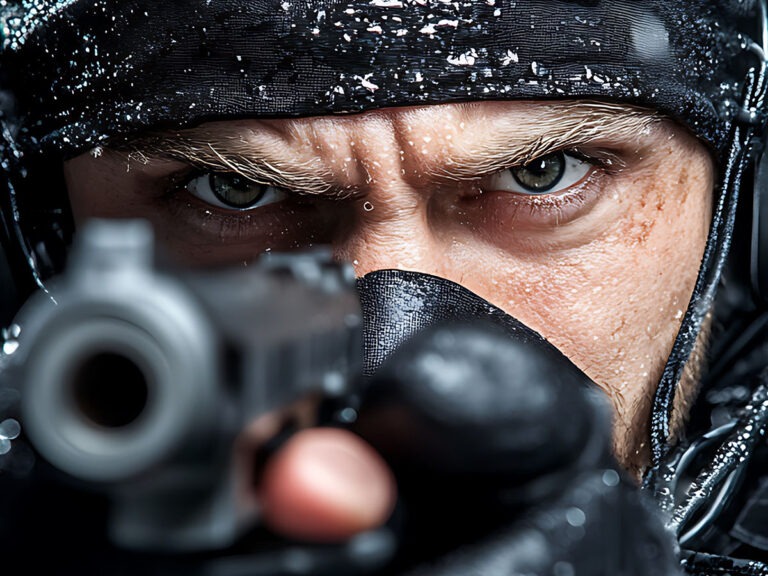
Lessons from William Aprill on criminal violence and the self-preservation mindset required to survive.
February 2018, I had the opportunity to take what would become one of the most impactful training classes of my life, Unthinkable: Tactics and Concepts for the Gravest Extreme taught by William Aprill and Greg Ellifritz. This wasn’t your average pistol class or defensive tactics course. Instead, it challenged students to explore the psychology of violence, criminal victim selection and—most importantly—the internal mental shift required to survive the worst moments imaginable.
Today, I reflect not just on that class, but on the legacy of Aprill—a uniquely gifted trainer, mental health professional and former law enforcement officer—who we tragically lost too soon. The gun training world didn’t just lose a teacher; we lost a scholar, a mentor and a man who dared to examine the darkest corners of human behavior not out of morbid curiosity, but to help others better defend themselves against it.
Understanding The Criminal Mind
Aprill often said he didn’t teach people how to shoot better; he taught them how to think better. That was clear in Unthinkable, where we spent hours digging into how violent criminal actors actually think and operate. Unlike many of us whose lives are governed by laws, ethics and empathy, criminals often grow up in an entirely different moral ecosystem—where violence is normalized, manipulation is survival, and victim selection is a tradecraft.
Aprill’s background as a mental health professional and former deputy sheriff gave him rare insight. He understood not just the behavior of criminals, but their developmental path. He pointed out that, for example, the average age of a first felony arrest for offenders who go on to kill police officers is just 11 years old. By the time they’re in their 20s, many of these individuals have spent more than a decade refining their ability to identify soft, unaware, compliant targets.
As Aprill explained, criminals select victims using the same kind of fast, instinctive thinking that concealed carriers rely on in a defensive encounter. But unlike us, their entire lifestyle is often geared toward sizing people up, probing boundaries and exploiting weaknesses. We might shoot 200 rounds at the range in a month. They’ve been living their “training” every day for years.
Deselection As A Way Of Life
One of the most transformative ideas I took from Aprill’s class was the concept of deselection. Put simply, the goal isn’t to win a fight—it’s to avoid being selected for the fight in the first place. “Criminals don’t want to fight,” he said. “They want to win.” If they sense that you’re paying attention, carry yourself confidently or might present too much of a problem, they’ll likely move on.
But this isn’t something you can fake at the last second. You can’t slap on a “tough guy” mask when you’re walking to your car in a dark parking lot and expect it to work. As Aprill emphasized, deselection must be a lifestyle. Your posture, your awareness, your decisions all must consistently broadcast the message: “I’m not worth the trouble.”
He illustrated this with a simple example. Walk like a meerkat. Scan overtly. Look people in the eyes. Criminals, he explained, don’t want to be seen. If they think you saw them, that alone can often break the attack cycle. Awareness, even more than armament, can be your most potent form of defense.
Violence Without Hesitation
While most training emphasizes the hardware—gear, guns, gadgets—Aprill focused on the software. Are you psychologically prepared to act with violence if you must? Not just draw and shoot, but strike, claw, gouge or even beat someone to death with a blunt object if it’s the only option?
He didn’t romanticize it. He didn’t glorify violence, but he also didn’t sugarcoat what survival sometimes demands. He made clear that in the gravest extreme, our polite, civilized sensibilities can become a liability. He encouraged us to rehearse not just techniques, but mental scripts to visualize the level of force we might need to use and to grow comfortable with it—not because we want to use violence, but because when it is necessary, hesitation can be fatal.
Training For The Mind And Body
The Unthinkable class offered practical skills—escaping restraints, disarming attackers, tactical first aid—but its real value was the shift it created in mindset. Aprill and Ellifritz helped bridge the gap between theoretical preparedness and actionable readiness. Aprill’s portion in particular was unique in that it wove together neuroscience, criminal psychology and tactical application in a way that few instructors even attempt, let alone master.
For those in the gun world who obsess over drills, groupings and gear, Aprill’s message was both a challenge and a wake-up call: If you’re not training your mind, you’re only halfway prepared.
A Legacy That Endures
With Aprill’s passing, the firearms community lost one of its most brilliant and compassionate voices. But his impact lives on through the countless students he educated and inspired, and through the trainers who now incorporate his insights into their own curriculum.
David Yamane of Gun Culture 2.0 called Aprill “so far ahead of so many in the gun training community he may well have been on Gun Culture Version 4.5.” That sounds about right. His work was a rare synthesis of empathy and hard realism, of academic rigor and tactical relevance. Even though you can no longer take the Unthinkable class with Aprill, a lot of his work is available on the internet, and Yamane has made a nice compilation available on this website at Gun Culture 2.0.
I consider myself incredibly fortunate to have trained under him, and as a tribute to his legacy, I encourage everyone reading this to dive into his recorded lectures, revisit his interviews and most importantly, apply what he taught.
If you’re serious about self-defense, do yourself this favor: Take a course that challenges not your shooting ability but your thinking ability.
And carry Aprill’s message with you. Train your mind to embrace awareness as a constant task, cultivate the ruthlessness needed for counterassault and embody the principles of deselection—projecting strength and vigilance to deter predators. By internalizing these lessons, you become hard to kill, hard to fool and the kind of person a violent criminal actor passes by, choosing an easier target instead.
Editor's Note: This article originally appeared in the September 2025 issue of Gun Digest the Magazine.
More On Handgun Training:
- Video: Target Transition Training With The Dot Drill
- The Shot Timer And Defensive Handgun Training
- Gun Digest’s 10 Best Shooting Drills And Firearms Training Posts
- MantisX: Simple And Effective Training
- Video: Is A Full-Sized Pistol The Best Training Option?

Next Step: Get your FREE Printable Target Pack
Enhance your shooting precision with our 62 MOA Targets, perfect for rifles and handguns. Crafted in collaboration with Storm Tactical for accuracy and versatility.
Subscribe to the Gun Digest email newsletter and get your downloadable target pack sent straight to your inbox. Stay updated with the latest firearms info in the industry.

![Best Concealed Carry Guns In 2025 [Field Tested] Wilson Combat EDC X9S 1](https://gundigest.com/wp-content/uploads/Wilson-Combat-EDC-X9S-1-324x160.jpg)


![Best 9mm Carbine: Affordable PCCs [Tested] Ruger Carbine Shooting](https://gundigest.com/wp-content/uploads/Ruger-Carbine-Shooting-100x70.jpg)
![Best AR-15: Top Options Available Today [Field Tested] Harrington and Richardson PSA XM177E2 feature](https://gundigest.com/wp-content/uploads/Harrington-and-Richardson-PSA-XM177E2-feature-100x70.jpg)

Great article! One of the few that points out the development and mindset of a criminal. The biggest thing about criminals (IMHO) is their boldness. Some are smooth, good looking and have a line, they could sell ice cubes to eskimo’s, others carry the bad guy persona at all times.
A career criminal one time enlightened me about not guilty people. He said the problem with the not guilty that are accused of a crime is that they want to protect their good name. he said us criminals will work for a plea deal.